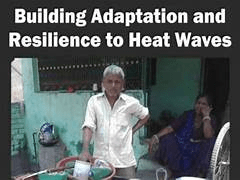The Hindu Editorial Analysis
27 May 2025
Focus on heat-resilience despite the monsoon
(Source – The Hindu, National Edition – Page No. – 08)
Topic: GS 2 & 3: Public Health | Climate Change and Disaster Preparedness | Social Justice | Governance and Policy Response
Context
- India has witnessed extreme heatwaves, straining healthcare systems, especially in vulnerable communities.
- The editorial argues that the current approach remains crisis-driven and reactive, whereas climate-resilient health systems must be preventive, interdisciplinary, and equity-rooted.

Introduction
The monsoon may offer temporary relief, but India’s real public health emergency is the rising heat.
With increasing temperatures, the burden of heatstroke, dehydration, and chronic illness is disproportionately borne by informal workers, the elderly, and slum dwellers.
Heat resilience is not just a health issue—it is a social equity and infrastructure challenge that requires urgent system redesign.
Problem: A Heatwave Health Crisis
1. Health System Overload
- India’s response focuses on emergency care (IV fluids, hospital beds) rather than prevention.
- This overreliance on hospitals fails to address heat vulnerability before it becomes life-threatening.
2. Hidden Burden and Misdiagnosis
- Heatstroke often goes undiagnosed or mismanaged, especially in emergency settings.
- Symptoms like fatigue or confusion are frequently missed, leading to preventable deaths.
A Proactive Approach: Prevention Begins with Primary Care
1. Role of ASHAs and Health Centres
- Accredited Social Health Activists (ASHAs) and wellness centres are vital as “heat-safety champions”.
- With training, they can alert communities, distribute hydration kits, and guide vulnerable groups to safety.
2. Integrating Heat Precaution in Chronic Care
- Patients with diabetes, heart disease, kidney ailments, and mental health issues must be closely monitored during heatwaves.
- Adjusting medication and daily routines becomes crucial in extreme temperatures.
Bridging the Gaps: What Needs to Change
1. Standardised Clinical Protocols
- Hospitals need clear protocols for diagnosing and treating heat-related illnesses, including:
- Pre-stocked cooling kits
- Regular heat emergency drills
- Follow-ups post-discharge
2. Interdepartmental Coordination
- Preventing exposure requires urban planning (cool housing), labour regulation (outdoor work hours), water security (summer supply), and climate-informed governance.
3. Community-Centred Resilience Models
- Initiatives like Ahmedabad’s early warning systems and hydration drives must be scaled nationally.
- Use of mobile alerts, door-to-door messaging, and WhatsApp groups can empower communities with real-time actions.
Equity and System Reform
1. Heat Disproportionately Affects the Poor
- Street vendors, informal workers, and residents of poorly ventilated areas cannot simply “stay indoors”.
- These populations must be protected through targeted shelters, cooling centres, and proactive medical checks.
2. The Science-Justice Imperative
- Heat resilience must be science-driven and equity-anchored.
- Solutions must address who suffers most, why, and how—combining data with empathy and policy with urgency.
Conclusion
India’s heat crisis is here, not in the future.
We must shift from firefighting to foresight—from emergency IVs to early intervention and urban redesign.
The path forward lies in equity, collaboration, and preparedness.
The time is not next summer. The time is now—to protect, prevent, and pioneer a climate-resilient future for all.


